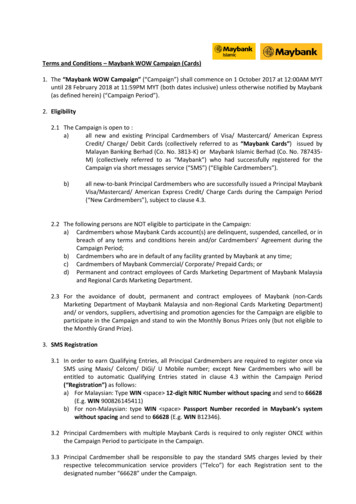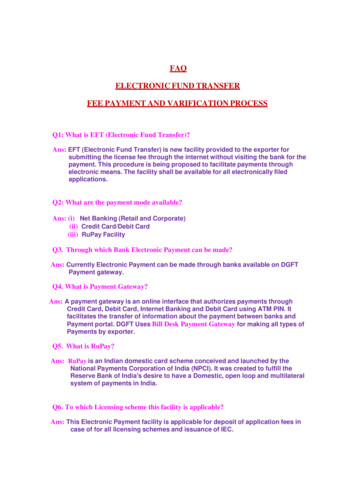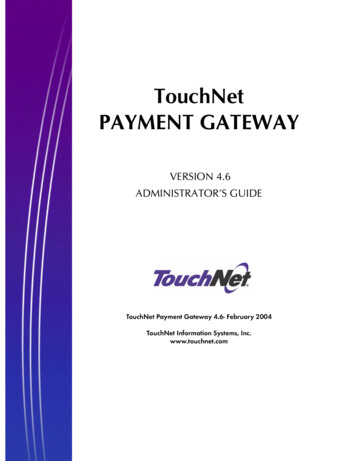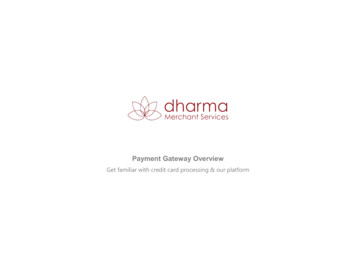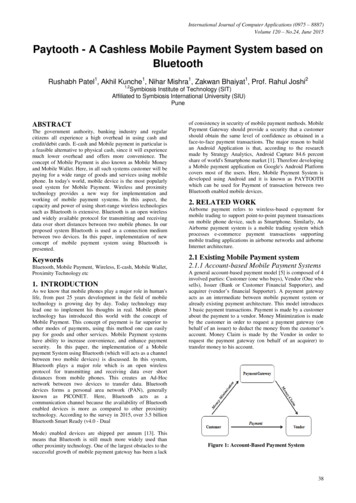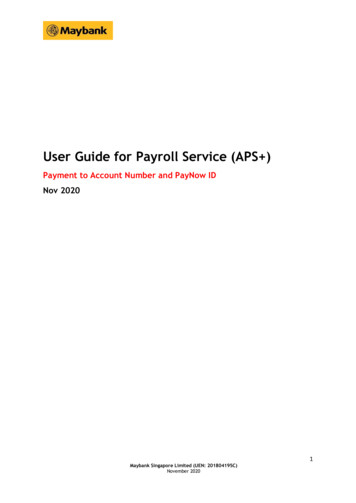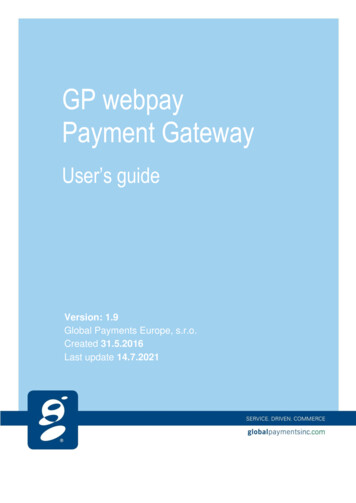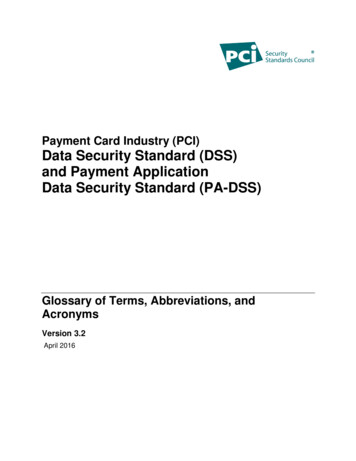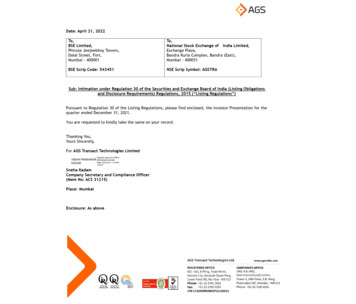
Transcription
Cards Payment Gateway1. What are the Benefits of Cards Payment Gateway?I.II.III.IV.The largest base of credit and debit cardholders available to merchants participating in themarketing programmesYou can view the transaction record on the Maybank eBPG Portal real timeHelpdesk / Merchant service hotline and technical support team24-hour authorisation service for customers2. What are requirements to apply Card Payment Gateway?I.II.III.IV.The company must be locally registered in Malaysia.The company must have a Maybank business current account.The company must have an appropriate office site and should not be operating frompersonal home/residential area.The website must be ready and comply with Maybank’s website checklist requirements asbelow:a) Minimal Website Requirement The website must be ready for publishing or being developThe website must use at least 128-bit Secure Socket Layer (SSL) encryption technique orprotocolThe website must belong to the registered company which submit this application toMaybankAccepting only 3D secure transactionb) Merchant Information Merchant must clearly display information about the company and address on the websiteMerchant is not allowed to share the eBPG facilities with other company or sub-merchantc) Product Information The website must clearly indicate details of your products and servicesMerchant must clearly display the total cost (including the cost of delivery, handling andapplicable taxes of your products and services) on the website
d) Payment Information & Security Merchant must clearly display the currency type on the websiteMerchant must provide an online invoice/receipt to customer upon completion of any card’stransaction via the website which contains the following:- Merchant’s trading name- Merchant’s website (URL)- Transaction amount- Currency Type- Transaction Date- Cardholder’s Name- Authorization Code- Description of Products and Services- Return / Refund Policy Merchant must send a confirmation e-mail to customers upon the successful purchase ofproducts and servicesMerchant must make sure that the name (Trading name) and country that appear on thecardholder’s statement easily recognizable to the cardholder as stated on the website.Ifmerchant transacts on behalf of customers by storing their credit card details into thepayment server, merchant must present a PCI-DSS to Maybank.e) Delivery / Shipping Merchant must display a clear Terms & Condition and/or refund policy on the website (e.g.method of return, days of refund, etc)The customers have to expressly accept the merchant’s Terms & Conditions (e.g. onlinetransactions, return policy, etc) before completing the transactionMerchant must display a clear delivery/shipping method on the website (e.g. courier, parcellocker, COD)Merchant must provide estimated time of delivery/shipping to customerMerchant must provide a delivery/shipping tracking reference number to customerf) Support Merchant must clearly display customer service details on the website (e.g. phone numberwith country code or e-mail address)Merchant must store customer profiles on the website for support purpose
Merchant needs to develop or set-up own merchant’s web server at merchant own cost forthe integration with Maybank eBPG.Merchant must have fraud mitigation policy and/or system that can mitigate the onlinecredit card fraud risks. If Merchant used any of the anti-fraud warning systemsoftware/application, the system must at least but not have limited to the followingfeatures:a) Web site securityWe strongly suggest that merchant's e-commerce web site is equipped with security facilities likeSSL, encryption and firewall. This way, the merchant's database (especially the sensitive salesinformation) and its transmission are safe from being accessed by outsiders.b) Order detailsMerchants should urge customers to provide adequate information upon ordering, especiallycontact information of the customers. Make sure that the customer is a legitimate cardholder. Moreattention is required for suspicious orders (like remote delivery addresses or simultaneous multipleorders).c) Freemail addressSome fraudsters attempt to mask their identity by using a freemail address. While most users offreemail addresses are indeed legitimate, caution should be exercised for orders with freemailaddresses, especially when this is the only way to contact the customers.d) Out-of-normMerchant should be wary of orders that falls outside usual ordering patterns, like bulk orders orpurchases that greatly exceed the average transaction amount.e) IP recordBeware of orders made from odd locations (which are sometimes traceable with the IP addresses),especially where credit card fraud is more common.f) Proof deliveryGet a signed proof of delivery or receipt if available upon retrieval request.
g) ReturnMerchants should devise and maintain clear, easy to understand and consistent product returnpolicies to keep customers well informed3. What are the types of cards can Cards Payment Gateway accept?Cards Payment Gateway accepts VISA, Mastercard and American Express Cards4. What are the fees that I have to pay?The Merchant Rate, setup fee (if applicable) and annual maintenance fee (if applicable) will beprovided in the Letter of Offer upon application approved.5. Is there any testing required after Maybank eBPG integration is completed?Yes, a testing is required once the integration process is completed. This test will take about three(3) days and you may extend the testing date provided you have obtained confirmation from thebank. You are given six (6) months to complete the integration and testing with Maybank eBPG,failing which the offer will lapse6. What is the notification period before going Live?Once the testing is successful, you can request to be in the live environment. You are required tonotify the bank 3 (three) days in advance.Are there any "best practices” guidelines for E-Commerce Merchants?I.Understand the risk of E-Commerce environment.Merchant needs to understand the risks of selling over the Internet as the purchaser may not be thegenuine cardholder.II.a)b)c)To maintain high customer satisfaction to avoid any customer disputes. For example:Goods and services are described accurately on your websites.Notify cardholder of any delays.Deliver merchandise on a timely basis and advised customers when they can expect it.
III. Recommended internal merchants fraud prevention system:a) Required transaction data fieldsRequired transaction data fields in website that can help to identify risk and require the customer tocomplete them. This information will help merchant to assess the fraud risk of a transaction. Editand validate required data field in real time. Key risk data fields include: Demographic information such as telephone numbers, that can be validated using telephonedirectory and to verify the transaction with the customers.E-mail address, particularly when it involves an ‘anonymous’ service.Cardholder name and billing address can be validated using directory.Shipping name and address, particularly if this information is different from the cardholder’sbilling information.b) Cardholder validation by: Check the validity of the customer’s telephone number, physical address and e-mail address.Screen for high-risk international addresses.Test the validity of the e-mail address by sending an order confirmation messageEstablish effective procedure for cardholder verification calls.C) Tracking and analysis activity at merchant in monitoring the patterns of risk exposures.Examples: Track the Web addresses or IP addresses that are used to reach merchant websites.Collect and analyze Internet customers ‘click through’ patterns for fraud risk screening.Track purchase patterns of registered customers.Track multiple order decline rates based on card number, customer IP address, etc.d) Establish fraud screening / monitoring transactions. Establish individual cardholder limits based on the number and amount of transactions thathave been approved within a specified number of days. It enables adjustment of limitsaccording to customer purchase patterns.Establish limits for single transaction amounts and consecutive repeat sales.Ensure the velocity limits are check against multiple characteristics including billing address,shipping address, telephone numbers and e-mail address.Check records to see whether the same delivery address has been used before with differentcard details.Contact the cardholders who exceed review limits to determine transaction activity islegitimate.
iv. Data SecurityConduct annual review of systems control.v. Transaction handling / storing:a. Storing of minimal information for card-not-present environment: The name as appears on the cardA customer contact phone number. Always ask for a permanent number.b. Merchant may store the transaction information for record purposesc. Merchant needs to ensure customer information is destroyed when it is no longer needed.vi. RemarksAll the above E-Commerce best practices are guidelines for E-Commerce merchants to ensure theintegrity of payment services provided to customers. You may conduct additional practices inmitigating disputes and fraudulent transactions at their establishment7. How will my funds be deposited?For all settled transactions, your funds will be deposited into your current account on the nextbusiness day8. Where can I view the transaction records?You can view this on the Maybank eBPG Portal. You will be provided with an account and logincredentials.9. Where can I view the settlement reports?You can view this on the e-statement Merchant Portal. You will be provided with an account andlogin credentials.10. Who can I contact for inquiry and clarification?For further assistance or clarification, you may email to merchantinquiry@maybank.com
Cards Payment Gateway accepts VISA, Mastercard and American Express Cards 4. What are the fees that I have to pay? The Merchant Rate, setup fee (if applicable) and annual maintenance fee (if applicable) will be provided in the Letter of Offer upon application approved. 5. Is there any testing required after Maybank eBPG integration is completed?
